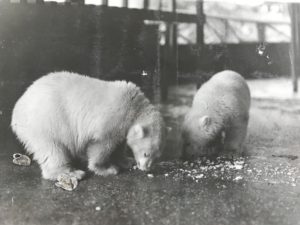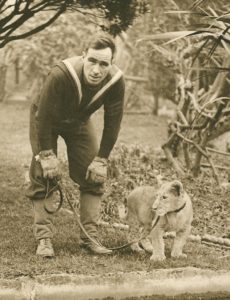In 1832 the Fourth Sea Lord of the Admiralty suggested there was a need for ‘theoretical instruction’ in gunnery. Thus what had been previously considered an art became a science.[1] Marine artillery embraced the science and technology of the age, and this modernisation of gunnery was aligned with a transition from sail to steam ships. As a consequence, sailor lives changed dramatically from that time. However, as naval life became highly technical, and warfare became a science, a human desire was expressed for a sailorly re-enchantment, or reconnection, with the previous symbiosis with the natural world. For the Royal Navy in Portsmouth, evidence of this can be witnessed be the creation of a zoo and farm which flourished on the newly-built School of Naval Gunnery on Whale Island up until the Second World War.
The Portsmouth Gunnery School had been on the 104-gun warship HMS Excellent, but the Admiralty instructed that land was to be reclaimed in the Fountain Lake area of Portsmouth Harbour, and by 1885 an island had been created for the instruction of naval artillery. There was much consideration over its landscaping and care was taken to cultivate suitable plants for the island in order to create pleasant environment. Indeed, professional advice was taken in 1891 from Kew Gardens with regard to which plants would be suitable for the ‘sea air.’[2]
From its inception there was also an animal presence on the island; working animals, horses, dogs and rat catching cats joined the sailors from the island’s earliest days. From this a refuge for other animals soon evolved. A rather mundane start to the zoo commenced when ‘twenty five pairs of rabbits [were] set adrift on the island by one Commander Oxley in 1877.’[8] However, this was soon overtaken by many well documented animals – and polar bears, lions, kangaroos and sun bears were among the most unexpected creatures to be found in the zoo. Inhabitants came from a number of sources; a pack of foxhound puppies from a local hunt, monkeys and parrots returned from sea voyages and other ships animals were deposited at the zoo. This had consequences for animals and sailors alike as gradually parts of the island developed into a haven from harsh lives at sea, and an escape from the rationalisation and systemisation of maritime artillery. It was remarked that:
‘The Navy’s zoo differs most markedly from others … so many specimens are experienced seafarers. Pets which have outgrown their welcome aboard battleships and cruisers are sent by harassed captains to the Whale Island authorities.’[9]
By the mid 1930s Whale Island was home to a private ‘Sailor Zoo’ that provided a hint of the magical, and a local mythology was built on stories of exotic animals and beautiful gardens that existed within the confines of the gunnery school. The zoo provided a sailor pastime that was enjoyed by all ranks. In addition, it became famed in the wider civilian community when public open days proved it to be extremely popular.[3]
Re-enchantment – the zoo as an escape
It has been well documented that sailors had a strong affection, curiosity and abiding respect for the natural world, especially for the animals and birds they met on their travels and maritime superstition engendered a feeling of obligation and reverence towards the non-human world. Sailors had animals on ships both as a food source and as companion animals. In addition it was common for animals to be given as gifts to ships companies and for sailors to buy ‘exotic’ animals on their travels.
Within the wider civilian context of animal keeping and exhibiting, zoos increased in popularity in the early twentieth century. Interests in the ‘exotic’ became prevalent and the zoo reflected the sailor/animal relationship and, as Hoage and Deiss suggested, ‘the establishment and use of a menagerie may be considered an … expression of deep-seated cultural values.’[6] Despite local folklore and a few newspaper articles from the 1930s there is little evidence of the sailor zoos existence, yet the zoo was ‘the expressive dimension of human life.’[7] The zoo could be seen as an ‘oppositional re-enchantment’ that subverted the rational cold hard science of gunnery. The zoo grew in the period when naval life, previously dependent on human connectivity with the sea and skyscape, became dependent on machines and technology and there became a ‘disenchantment [with] the world [that] lay right at the heart of modernity.’[4] The zoo provided a release from this disillusion and a re-enchantment for the sailors who worked there. The local newspaper reported on the lands as if they were an oasis which the public at large was missing out on:
‘Tucked away beyond the Dockyard in Portsmouth Harbour… There is much that is “hush-hush” [about Whale Island] but its rose gardens and zoo might well be thrown open to visitors during Navy week.’[5]
Many stories exist in the zoo’s folklore and the more celebrated residents were those of an exotic nature. For example several species of bear are recorded as having been resident. The earliest bear inhabitant was Amelia who had been gifted by the people of British Columbia and was transported especially from Comox, Esquimalt, on HMS Grafton.[10] However, the first celebrated bear for which there is photographic evidence was a Russian bear called ‘Baby.’ A news report of the time characterised Baby:
“The greatest handful for the keepers is undoubtedly Baby, [who] has been an inmate barely a year yet. Baby has caused a little excitement more than once… Baby’s temper was not so sweet as the honey she liked. …’[11]

Polar bear cubs Barbara and Nicholas (Courtesy of Brain Witts, Curator of the HMS Excellent collection)
Two polar bears were diplomatic gifts to the Navy and their provenance is recorded clearly in the zoo ledger for 1936:
‘HBM[12]Consul at Tromso, Norway, presented 2 Polar Bears (cubs) aged 2 months to the island. They arrived on 20th May 1936, having taken passage in Trawler ‘Malmata’ to Grimsby, hence by train.’
The bears were matched in their star quality by the lions. Records show that the zoo hosted Peter and Rex two adult males and Lola and Lorna two females, between them two litters of cubs were born. Lola was presented to Whale Island by Dr M. A. Molloy of the Department of Veterinary Science and Animal Husbandry, Dar es Salaam, Tanganyika Territory. It was recorded that she arrived in Portsmouth on 12 November 1934, having taken passage in the SS Dunbar Castle.[13]
Although it is recorded that a lion was ‘strolling peacefully along the path on top of the parade ground’[14] having escaped whilst her quarters were being cleaned, by far the most bizarre story in the history of the Sailor Zoo is that of the ‘Boy who had no fear’.[15] This event became national news and records the occasion when a visiting ten year old naval cadet attempted to distract or taunt the lions.[16] The Evening News of 3 May 1939 states that the cadet fell into the lion’s den but other reports suggest that he just got too close to the inner cage railings.
‘Before he could get away, both lions had attacked him and clawed him towards the cage.’
All reports say that the presence of mind of nearby sailors saved the boy when they beat the lion (Topsy) off with sticks. The island’s doctor, Surgeon Commander H. E. Scargill, treated the boy before he was taken in a Police Ambulance to the Royal Portsmouth Hospital.
Not all animal residents were so intimidating and many of the exhibits were fairly domesticated such as the wallabies and deer that are recorded. In addition there was a considerable aviary with thirty four species of bird logged in the 1936 record book. The enclosed birds were accompanied by water fowl that lived on and around the ornamental pond designed and created by officers and men on the island. The pond was close to a famed rose garden, the remains of which still exists.
The zoo was disbanded at the onset of the Second World War as there was an expectation that the Island would be a target for aerial bombing and the animals were distributed to other parts of the country. However, this brief snapshot of the zoo demonstrates that it provided respite from newly modern forms of naval life, a magical enchantment in juxtaposition to the science and rationalisation of gunnery and ship propulsion, as the Navy moved from the ‘natural’ maritime environment to the ‘scientific’ in ‘complicated and contradictory times.’[17]
Read Part 2 – The Whale Island Farm
Notes
[1] Anon (1919) , A Short History of Whale Island: Compiled from Information Supplied by Past and Present Officers and Men (2nd Edition). Sir J. Pechell wrote in detail to Admiral Sir Thomas Foley, Commander in Chief at Portsmouth, about his desire for a proposed School of Gunnery Instruction.
[2] Robert Travers Young. The House that Jack Built: The Story of HMS Excellent. (Aldershot: Gale and Polden Ltd, 1955).
[3] ‘Keepers in Chief of the Navy’s Pets,’ The Evening News, 30/01/1932.
[4] Richard Jenkins. “Disenchantment, Enchantment and Re-Enchantment: Max Weber at the Millennium.” Max Weber Studies 1, No. 1 (2000); pp. 11-32.
[5] ‘The Bear that “cleared the Decks on a Battle Ship”’ The Evening News 03/08/1937.
[6] Robert J. Hoage and William A. Deiss. New Worlds, New Animals: From Menagerie to Zoological Park in the nineteenth century. (Baltimore & London: The John Hopkins University Press, 1996), 19.
[7] Jenkins (2000) Disenchantment, Enchantment and Re-Enchantment.
[8] ‘The Bear,’ The Evening News.
[9] ‘The Bear,’ The Evening News.
[10] Amelia died in 1903. Esquimalt became the headquarters of the Royal Navy’s Pacific fleet in 1865 (until 1905) and HMS Grafton had been flagship of the Pacific Fleet from 1901.
[11] ‘Keepers in Chief,’ The Evening News.
[12] His Britannic Majesty
[13] HMS Excellent Zoo ledger, January 1936
[14] Travers Young. The House that Jack Built: The Story of HMS Excellent, 53.
[15] ‘The Boy who had no fear’ Daily Mirror, May 4th 1939
[16] For example, the story appeared in the press om 04/05/1939: ‘The boy who had no fear,’ Daily Mirror, ‘Mauled by Lioness’ The Evening News, ‘Boy Clawed at Zoo’ Daily Herald.
[17] Jenkins, Disenchantment, Enchantment and Re-Enchantment, 11-32











Comments are closed.